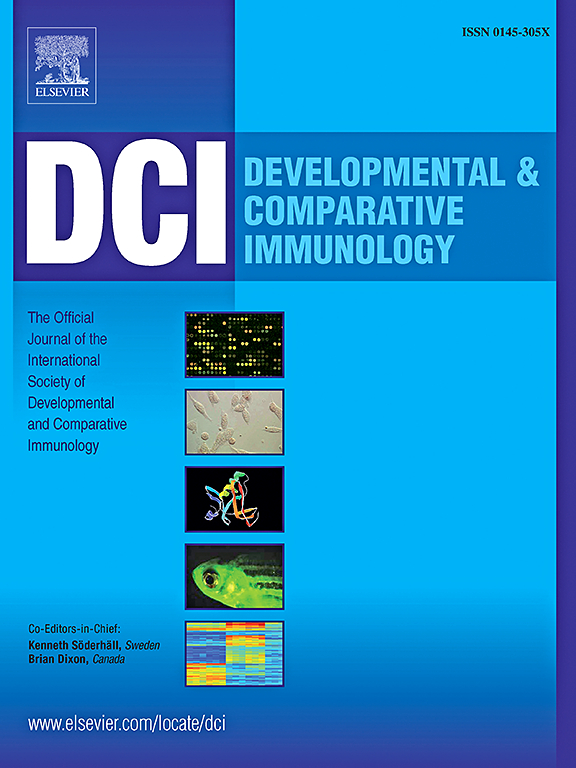Mx of Sebastes schlegelii: expression pattern, antibacterial activity and antiviral mechanism
IF 2.4
3区 农林科学
Q1 FISHERIES
引用次数: 0
Abstract
Myxovirus resistance (Mx) is a classical antiviral molecule that has been well understood in mammals. However, very limited studies on Mx antiviral activities have been documented in teleosts. In the present study, a novel Mx (SsMx) was cloned from black rockfish (Sebastes schlegelii) and the immunological activities of SsMx were examined in vitro and in vivo. SsMx contained conserved structural and functional domains including GTPase domain and GTPase effector domain. Quantitative real-time PCR (qRT-PCR) revealed that SsMx is extensively distributed in the immune cells and tissues examined with higher levels in spleen and liver. The mRNA expression of SsMx was significantly upregulated in head kidney, spleen and head kidney macrophages after pathogen infection. Recombinant SsMx (rSsMx) exhibited apparent binding activities against different bacteria in vitro. In vivo studies showed that rSsMx reduced pathogen dissemination and replication in head kidney and spleen. The subcellular localization results demonstrated that SsMx was predominantly distributed in the cytoplasm of transfected cells. Furthermore, SsMx was observed to inhibit apoptosis in virus-infected cells and reduce viral replication by interfering with the viral entry. SsMx and Spring viremia of carp virus Glycoprotein (SVCV G) were found to interact strongly with each other by co-immunoprecipitation and co-localization. These findings reveal an important role of SsMx in defencing the early stage of SVCV infection, which will be helpful to understand the molecular details of the antiviral mechanisms mediated by Mx proteins in teleosts.
schlegelii血吸虫Mx的表达模式、抑菌活性及抗病毒机制
黏液病毒耐药性(Mx)是一种经典的抗病毒分子,在哺乳动物中已被充分了解。然而,关于硬骨鱼中Mx抗病毒活性的研究非常有限。本研究从黑岩鱼(sebases schlegelii)中克隆了一种新的Mx (SsMx),并对其体外和体内的免疫活性进行了检测。SsMx包含保守的结构域和功能域,包括GTPase结构域和GTPase效应域。实时荧光定量PCR (Quantitative real-time PCR, qRT-PCR)显示SsMx广泛分布于免疫细胞和组织中,在脾脏和肝脏中含量较高。致病菌感染后,头肾、脾和头肾巨噬细胞中SsMx mRNA表达显著上调。重组SsMx (rSsMx)在体外对不同细菌表现出明显的结合活性。体内研究表明,rSsMx可减少病原体在头部肾和脾脏的传播和复制。亚细胞定位结果表明,SsMx主要分布在转染细胞的细胞质中。此外,SsMx被观察到抑制病毒感染细胞的凋亡,并通过干扰病毒进入减少病毒复制。通过共免疫沉淀和共定位,发现SsMx与鲤鱼病毒糖蛋白(SVCV G)春季病毒血症相互作用强。这些发现揭示了SsMx在SVCV感染早期防御中的重要作用,这将有助于了解硬骨鱼中Mx蛋白介导的抗病毒机制的分子细节。
本文章由计算机程序翻译,如有差异,请以英文原文为准。
求助全文
约1分钟内获得全文
求助全文
来源期刊
CiteScore
6.20
自引率
6.90%
发文量
206
审稿时长
49 days
期刊介绍:
Developmental and Comparative Immunology (DCI) is an international journal that publishes articles describing original research in all areas of immunology, including comparative aspects of immunity and the evolution and development of the immune system. Manuscripts describing studies of immune systems in both vertebrates and invertebrates are welcome. All levels of immunological investigations are appropriate: organismal, cellular, biochemical and molecular genetics, extending to such fields as aging of the immune system, interaction between the immune and neuroendocrine system and intestinal immunity.

 求助内容:
求助内容: 应助结果提醒方式:
应助结果提醒方式:


